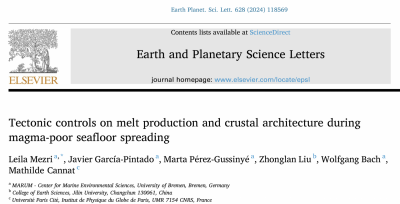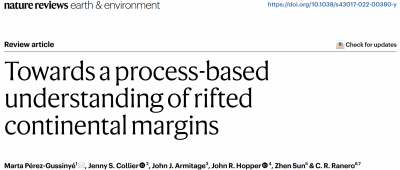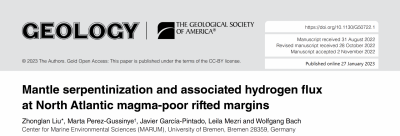- Cluster Ocean Floor
- Enabler MODELING
- News
- Publications
Publications
Mezri et al. (2024)

Slow and ultraslow spreading oceanic crust consists of a heterogenous mixture of serpentinised mantle and magmatic rocks. In these environments, both crustal architecture and faulting mode have been attributed to the interplay between magmatism and tectonics. Numerical models have investigated how variations in melt supply influence tectonics. However, how tectonics influences melt production and the formation of a heterogeneous crust is not well understood. Here, we use 2D numerical models to analyze how coupled tectonics, mantle melting, melt emplacement and serpentinization interact. Our model shows that ocean loading and crustal density promote fault offsets and durations. We focus on ultraslow, magma-poor ridges, in particular the Southwest Indian Ridge at 64°30′ East, which exhibits crustal thickening along detachment faults interpreted as a deep serpentinization front. We reproduce the observed bathymetry, seafloor morphology, shaped by alternating flip-flop detachments, and crustal thickness variations, ∼3–6 km, associated with deep along-fault serpentinisation. We find that in this magma-poor environment, where serpentinized mantle dominates crustal composition and magmatic effects on tectonics are limited, variations in melt production are the consequence of changes in mantle flow patterns in response to faulting. Early detachment evolution leads to a slow-down in mantle upwelling and melt production decrease. Late in the detachment life-cycle, antithetic faults in its footwall trigger enhanced mantle upwelling, increasing melt production. During the flip-flop detachment life-cycle, tectonically induced spatio-temporal variations in magma emplacement and serpentinisation contribute to the formation of a heterogeneous crustal architecture and magnetic signature of the seafloor.
Pérez-Gussinyé et al. (2023)

Raghuram et al. (2023)
Rifting can result in asymmetric conjugate margins. In numerical models with laterally homogeneous lithosphere, the polarity of the asymmetry is random and results from spontaneous strain localization on a dominant fault/shear zone. However, along the central South Atlantic, margin width is well correlated to the proximity of the rift to a craton during rifting. To understand the evolution of rifting close to a craton, we used numerical experiments that included a thick craton lithosphere adjacent to a thinner, mobile-belt lithosphere. When rifting starts close to the craton, i.e., ≤100 km, deformation focuses along a fault/shear zone dipping toward the craton, leading to cratonward asymmetric asthenospheric uplift and rift migration. This results in a narrow margin on the craton side and a wide margin on the mobile-belt side. Craton-related asymmetry results in the wide margin subsiding more than the narrow one, inducing the formation of large synrift sag basins in the wide conjugate, as in the South Atlantic. This differential subsidence is preserved for ∼100 m.y. after breakup and may partly explain the present-day higher dynamic topography close to cratons in the central South Atlantic. Mantle flow during asymmetric rifting leads to weakening of the craton lithosphere, partial intermixing, and recycling into the convective mantle, as interpreted for this sector of the South Atlantic ridge. Thus, rifting adjacent to a craton may have wide-ranging tectonic, stratigraphic, and compositional consequences that affect not only margin architecture, but also the development of subsequent dynamic topography and the spreading system.
Pérez-Gussinyé et al. 2023

Interactions between tectonic, magmatic, sedimentary and hydrothermal processes during rifting and break-up of continental lithosphere lead to a variety of rifted margin types. As potential reservoirs for mineral deposits and native hydrogen, and as sites for CO2 storage and generation of geothermal energy, rifted margins are likely to have a key role in the future transition to a carbon-neutral economy. In this Review, we discuss the wide variability of rifted margin anatomy in terms of the processes that shape them. We demonstrate that observations combined with models can provide a process-based understanding of margin evolution that allows any given region to be understood more holistically than with a static end-member type (magma-rich versus magma-poor) classification. Many margins show intermediate characteristics between those end-members. Even within end-member types, there are substantial structural variations, which are shaped by the feedbacks between inheritance, deformation, sedimentation, magmatism and fluid flow. A better understanding of these feedbacks is required to assess the potential of margins to support the carbon-neutral economy. Integration of observations and modelling will help to de-risk exploration of these environments. In particular, margins need to be characterized by integrated geophysical studies, including improved wide-angle seismic velocity models with closely spaced instruments together with advanced numerical modelling techniques.
Liu et al. 2023

Mantle serpentinization influences the rheology of altered peridotites and the global fluxes of energy and volatiles, the generation of seafloor and sub-seafloor chemolithotrophic life, and the carbon cycle. As a by-product of serpentinization, molecular hydrogen (H2) is generated, which supports chemosynthetic communities, and this mechanism may have driven the origin of life on early Earth. At continent-ocean transition zones (COTs) of magma-poor rifted margins, the mantle is exposed and hydrated over hundreds of kilometers across the rift, but the H2 fluxes associated with this process are poorly known. Here, we coupled a thermomechanical model with serpentinization reaction equations to estimate associated H2 release during mantle exhumation at COTs. This reproduced a tectonic structure similar to that of the West Iberia margin, one of the best-studied magma-poor margins. We estimated the rate of H2 production from mantle hydration at (7.5 ± 2.5) × 107 mol/(yr × km). By estimating the area of exhumed mantle from wide-angle seismic profiles at North Atlantic magma-poor margins, we calculated that the accumulated H2 production could have been as high as ∼4.3 × 1018 mol (∼8.6 × 1012 metric tons) prior to opening of the North Atlantic Ocean, at a rate of ∼1.4 × 1017 mol/m.y. This is one quarter of the total predicted flux produced by the global system of mid-ocean ridges, thus highlighting the significance of H2 generation at magma-poor margins in global H2 fluxes, to hydrogenothropic microbial life, and, perhaps, as a potential energy source.
Bradley et al. 2020

Microbial cells buried in subseafloor sediments comprise a substantial portion of Earth’s biosphere and control global biogeochemical cycles; however, the rate at which they use energy (i.e., power) is virtually unknown. Here, we quantify organic matter degradation and calculate the power utilization of microbial cells throughout Earth’s Quaternary-age subseafloor sediments. Aerobic respiration, sulfate reduction, and methanogenesis mediate 6.9, 64.5, and 28.6% of global subseafloor organic matter degradation, respectively. The total power utilization of the subseafloor sediment biosphere is 37.3 gigawatts, less than 0.1% of the power produced in the marine photic zone. Aerobic heterotrophs use the largest share of global power (54.5%) with a median power utilization of 2.23 × 10−18 watts per cell, while sulfate reducers and methanogens use 1.08 × 10−19 and 1.50 × 10−20 watts per cell, respectively. Most subseafloor cells subsist at energy fluxes lower than have previously been shown to support life, calling into question the power limit to life.



